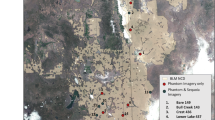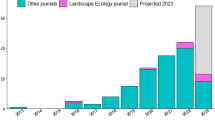
Overview
- The chapters provide real examples of remote sensing techniques applied to map a range of indicators required by conservation managers, such as habitat distribution and condition, biodiversity indicators or even individual plants with drones
- Special chapters on Remote sensing imagery preparation for ecological studies, assessment of the use of drones to map nesting bird colonies or invasive plant species
- Book sections lead the reader towards the specific application and every chapter provides practical lessons for nature conservation
Access this book
Tax calculation will be finalised at checkout
Other ways to access
About this book
This book and linked activities have been selected as finalists of the European Natura 2000 award 2020.https://natura2000award-application.eu/finalist/3126
Similar content being viewed by others
Keywords
Table of contents (16 chapters)
-
Front Matter
-
Part I
-
Front Matter
-
-
Part II
-
Front Matter
-
-
Part III
-
Front Matter
-
-
Part IV
-
Front Matter
-
Editors and Affiliations
About the editors
Prof. Richard Lucas, The University of New South Wales, School of Bio., Earth, Env. Science, Kensington, Australia
Dr. Clive Hurford, Natural Resources Wales, Pembroke Wales, United Kingdom
Bibliographic Information
Book Title: The Roles of Remote Sensing in Nature Conservation
Book Subtitle: A Practical Guide and Case Studies
Editors: Ricardo Díaz-Delgado, Richard Lucas, Clive Hurford
DOI: https://doi.org/10.1007/978-3-319-64332-8
Publisher: Springer Cham
eBook Packages: Biomedical and Life Sciences, Biomedical and Life Sciences (R0)
Copyright Information: Springer International Publishing AG 2017
Hardcover ISBN: 978-3-319-64330-4Published: 20 November 2017
Softcover ISBN: 978-3-319-87772-3Published: 11 September 2018
eBook ISBN: 978-3-319-64332-8Published: 06 November 2017
Edition Number: 1
Number of Pages: XII, 318
Number of Illustrations: 38 b/w illustrations, 64 illustrations in colour
Topics: Conservation Biology/Ecology, Remote Sensing/Photogrammetry, Biodiversity



